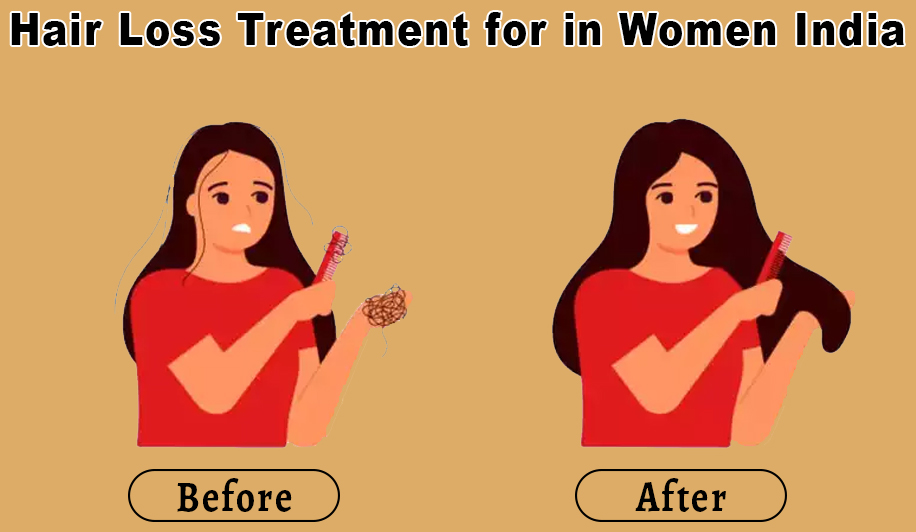Hair Loss Treatment For Women
Female pattern hair loss (FPHL) is a distinctive form of hair loss that occurs in women with androgenetic alopecia. Many women are affected by FPHL. In fact, around 40% of women by age 50 show signs of hair loss and less than 45% of women actually reach the age of 80 with a full head of hair.
1. What is female pattern hair loss?
Female pattern hair loss (FPHL) is a distinctive form of hair loss that occurs in women with androgenetic alopecia. Many women are affected by FPHL.In fact, around 40% of women by age 50 show signs of hair loss and less than 45% of women actually reach the age of 80 with a full head of hair.
In FPHL, there is diffuse thinning of hair on the scalp due to increased hair shedding or a reduction in hair volume, or both. It is normal to lose up to 50-100 hairs a day. Another condition called chronic telogen effluvium also presents with increased hair shedding and is often confused with FPHL. It is important to differentiate between these conditions as management for both conditions differ.
FPHL presents quite differently from the more easily recognizable male pattern baldness, which usually begins with a receding frontal hairline that progresses to a bald patch on top of the head. It is very uncommon for women to bald following the male pattern unless there is excessive production of androgens in the body.
2. What causes female pattern hair loss?
FPHL has a strong genetic predisposition. The mode of inheritance is polygenic, indicating that there are many genes that contribute to FPHL, and these genes could be inherited from either parent, or both. Genetic testing to assess risk of balding is currently not recommended, as it is unreliable. Currently, it is not clear if androgens (male sex hormones) play a role in FPHL, although androgens have a clear role in male pattern baldness. The majority of women with FPHL have normal levels of androgens in their bloodstream. Due to this uncertain relationship, the term FPHL is preferred to ‘female androgenetic alopecia’. The role of oestrogen is uncertain. FPHL is more common after the menopause suggesting oestrogens may be stimulatory for hair growth. But laboratory experiments have also suggested oestrogens may suppress hair growth.
3. What is the normal hair growth cycle?
Everyone is born with a fixed number of hair follicles on the scalp that produce hairs throughout life. Hair grows from the base of the follicle at a rate of about one centimetre a month for about three years. This growth phase is called anagen. After anagen, the hair dies (catagen hair) and no longer grows. It sits dormant in the follicle for a three-month phase called telogen. After telogen, the hair follicle undergoes another anagen phase to produce a new hair that grows out of the same follicle. As it grows, the old telogen hair is dislodged or pushed out. This is a cycle that continues throughout life.
4. What is Hair shedding?
Increased hair shedding or telogen effluvium is a feature to FPHL. Women can use the hair shedding guide below to define whether hair shedding is normal or excessive, To assess hair shedding, women should choose which of the 6 photographs of hair bundles best represents how much hair they shed on an average day. Doctors can use the hair shedding scale to score hair loss at each patient visit to assess response to treatment. It can also be used in clinical trials to assess new treatments for excess hair shedding.
5. What is Hair miniaturisation>
Unlike other areas of the body, hairs on the scalp to grow in tufts of 3–4. In androgenetic alopecia the tufts progressively lose hairs. Eventually when all the hairs in the tuft are gone, bald scalp appears between the hairs.
6. How long does it take for FPHL to progress?
FPHL can affect women in any age group but it occurs more commonly after menopause. The hair loss process is not constant and usually occurs in fits and bursts. It is not uncommon to have accelerated phases of hair loss for 3-6 months, followed by periods of stability lasting 6-18 months. Without medication, it tends to progress in severity over the next few decades of life.
7. What are the effects of female pattern hair loss?
Many studies have shown that hair loss is not merely a cosmetic issue, but it also causes significant psychological distress. Compared to unaffected women, those affected have a more negative body image and are less able to cope with daily functioning. Hair loss can be associated with low self-esteem, depression, introversion, and feelings of unattractiveness. It is especially hard to live in a society that places great value on youthful appearance and attractiveness.
8. Should I have any hormone tests done?
Blood tests include female and male sex hormone levels as well as thyroid function, as part of the diagnostic workup.
The majority of women affected by FPHL do not have underlying hormonal abnormalities. However a few women with FPHL are found to have excessive levels of androgens. These women tend also to suffer from acne, irregular menses and excessive facial and body hair.
These symptoms are characteristic of polycystic ovarian syndrome (PCOS) although the majority of women with PCOS do not experience hair loss. Less often, congenital adrenal hyperplasia may be responsible.
Results of PIDAM

